ECU CADILLAC XLR 2005 1.G Owners Manual
[x] Cancel search | Manufacturer: CADILLAC, Model Year: 2005, Model line: XLR, Model: CADILLAC XLR 2005 1.GPages: 438, PDF Size: 3.69 MB
Page 7 of 438
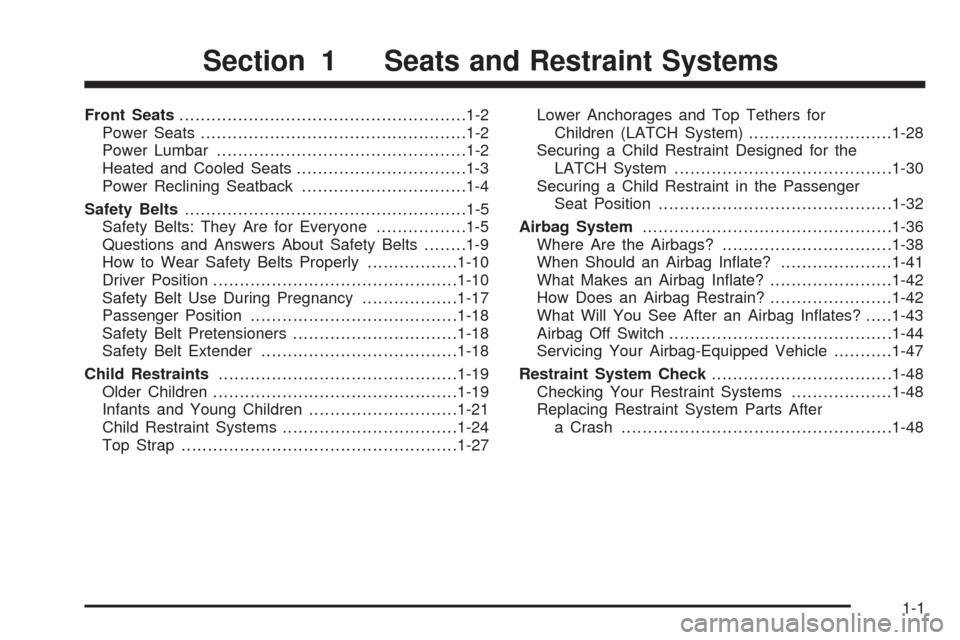
Front Seats......................................................1-2
Power Seats..................................................1-2
Power Lumbar...............................................1-2
Heated and Cooled Seats................................1-3
Power Reclining Seatback...............................1-4
Safety Belts.....................................................1-5
Safety Belts: They Are for Everyone.................1-5
Questions and Answers About Safety Belts........1-9
How to Wear Safety Belts Properly.................1-10
Driver Position..............................................1-10
Safety Belt Use During Pregnancy..................1-17
Passenger Position.......................................1-18
Safety Belt Pretensioners...............................1-18
Safety Belt Extender.....................................1-18
Child Restraints.............................................1-19
Older Children..............................................1-19
Infants and Young Children............................1-21
Child Restraint Systems.................................1-24
Top Strap....................................................1-27Lower Anchorages and Top Tethers for
Children (LATCH System)...........................1-28
Securing a Child Restraint Designed for the
LATCH System.........................................1-30
Securing a Child Restraint in the Passenger
Seat Position............................................1-32
Airbag System...............................................1-36
Where Are the Airbags?................................1-38
When Should an Airbag In�ate?.....................1-41
What Makes an Airbag In�ate?.......................1-42
How Does an Airbag Restrain?.......................1-42
What Will You See After an Airbag In�ates?.....1-43
Airbag Off Switch..........................................1-44
Servicing Your Airbag-Equipped Vehicle...........1-47
Restraint System Check..................................1-48
Checking Your Restraint Systems...................1-48
Replacing Restraint System Parts After
a Crash...................................................1-48
Section 1 Seats and Restraint Systems
1-1
Page 17 of 438
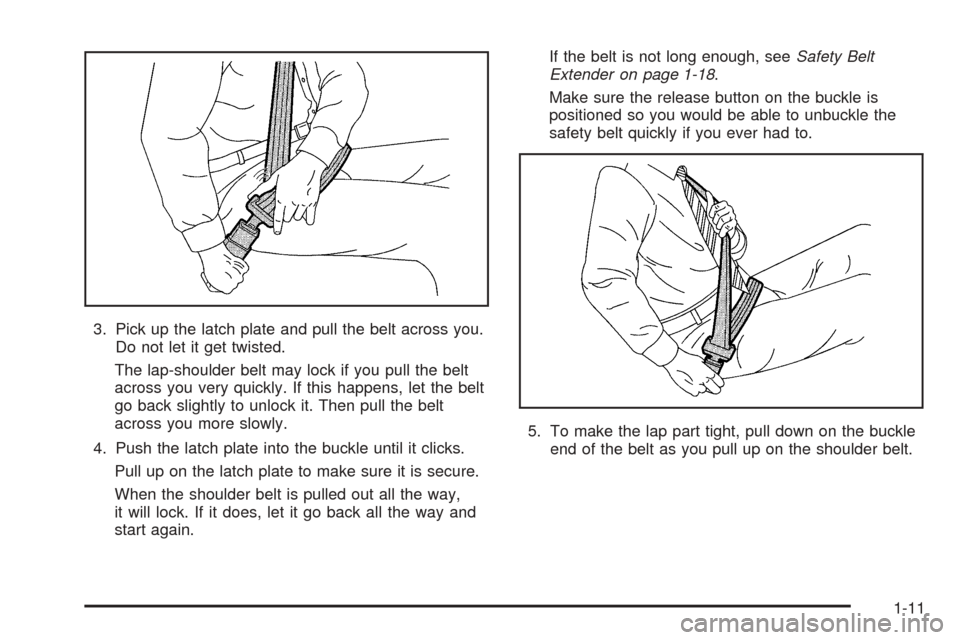
3. Pick up the latch plate and pull the belt across you.
Do not let it get twisted.
The lap-shoulder belt may lock if you pull the belt
across you very quickly. If this happens, let the belt
go back slightly to unlock it. Then pull the belt
across you more slowly.
4. Push the latch plate into the buckle until it clicks.
Pull up on the latch plate to make sure it is secure.
When the shoulder belt is pulled out all the way,
it will lock. If it does, let it go back all the way and
start again.If the belt is not long enough, seeSafety Belt
Extender on page 1-18.
Make sure the release button on the buckle is
positioned so you would be able to unbuckle the
safety belt quickly if you ever had to.
5. To make the lap part tight, pull down on the buckle
end of the belt as you pull up on the shoulder belt.
1-11
Page 24 of 438
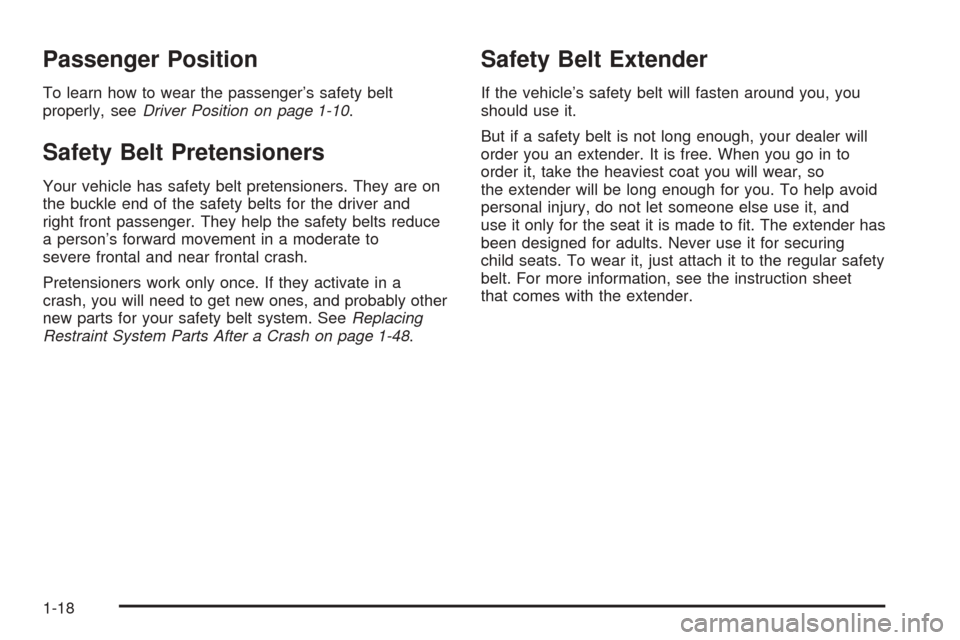
Passenger Position
To learn how to wear the passenger’s safety belt
properly, seeDriver Position on page 1-10.
Safety Belt Pretensioners
Your vehicle has safety belt pretensioners. They are on
the buckle end of the safety belts for the driver and
right front passenger. They help the safety belts reduce
a person’s forward movement in a moderate to
severe frontal and near frontal crash.
Pretensioners work only once. If they activate in a
crash, you will need to get new ones, and probably other
new parts for your safety belt system. SeeReplacing
Restraint System Parts After a Crash on page 1-48.
Safety Belt Extender
If the vehicle’s safety belt will fasten around you, you
should use it.
But if a safety belt is not long enough, your dealer will
order you an extender. It is free. When you go in to
order it, take the heaviest coat you will wear, so
the extender will be long enough for you. To help avoid
personal injury, do not let someone else use it, and
use it only for the seat it is made to �t. The extender has
been designed for adults. Never use it for securing
child seats. To wear it, just attach it to the regular safety
belt. For more information, see the instruction sheet
that comes with the extender.
1-18
Page 28 of 438
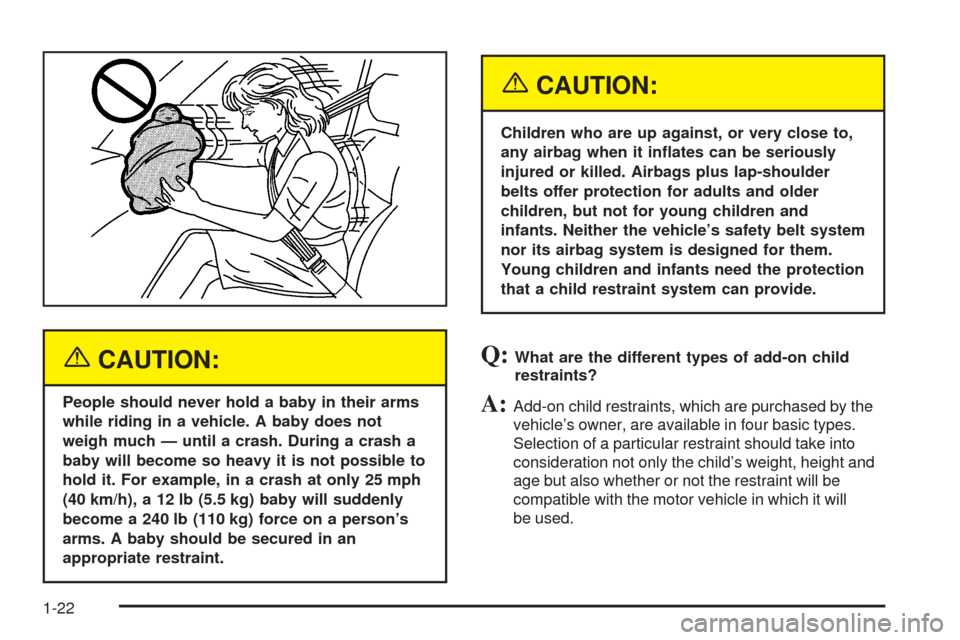
{CAUTION:
People should never hold a baby in their arms
while riding in a vehicle. A baby does not
weigh much — until a crash. During a crash a
baby will become so heavy it is not possible to
hold it. For example, in a crash at only 25 mph
(40 km/h), a 12 lb (5.5 kg) baby will suddenly
become a 240 lb (110 kg) force on a person’s
arms. A baby should be secured in an
appropriate restraint.
{CAUTION:
Children who are up against, or very close to,
any airbag when it in�ates can be seriously
injured or killed. Airbags plus lap-shoulder
belts offer protection for adults and older
children, but not for young children and
infants. Neither the vehicle’s safety belt system
nor its airbag system is designed for them.
Young children and infants need the protection
that a child restraint system can provide.
Q:What are the different types of add-on child
restraints?
A:Add-on child restraints, which are purchased by the
vehicle’s owner, are available in four basic types.
Selection of a particular restraint should take into
consideration not only the child’s weight, height and
age but also whether or not the restraint will be
compatible with the motor vehicle in which it will
be used.
1-22
Page 29 of 438
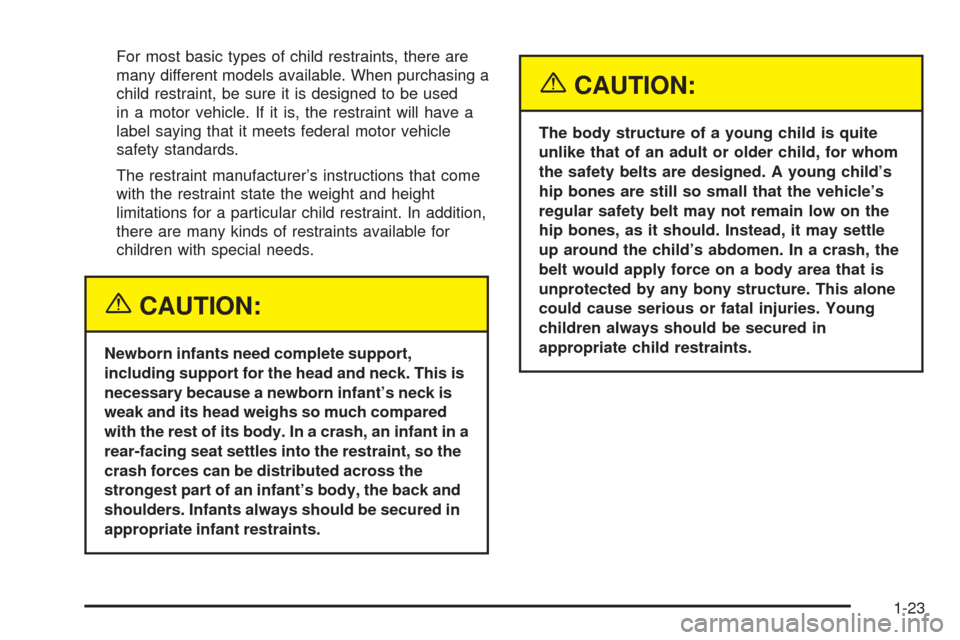
For most basic types of child restraints, there are
many different models available. When purchasing a
child restraint, be sure it is designed to be used
in a motor vehicle. If it is, the restraint will have a
label saying that it meets federal motor vehicle
safety standards.
The restraint manufacturer’s instructions that come
with the restraint state the weight and height
limitations for a particular child restraint. In addition,
there are many kinds of restraints available for
children with special needs.
{CAUTION:
Newborn infants need complete support,
including support for the head and neck. This is
necessary because a newborn infant’s neck is
weak and its head weighs so much compared
with the rest of its body. In a crash, an infant in a
rear-facing seat settles into the restraint, so the
crash forces can be distributed across the
strongest part of an infant’s body, the back and
shoulders. Infants always should be secured in
appropriate infant restraints.
{CAUTION:
The body structure of a young child is quite
unlike that of an adult or older child, for whom
the safety belts are designed. A young child’s
hip bones are still so small that the vehicle’s
regular safety belt may not remain low on the
hip bones, as it should. Instead, it may settle
up around the child’s abdomen. In a crash, the
belt would apply force on a body area that is
unprotected by any bony structure. This alone
could cause serious or fatal injuries. Young
children always should be secured in
appropriate child restraints.
1-23
Page 32 of 438
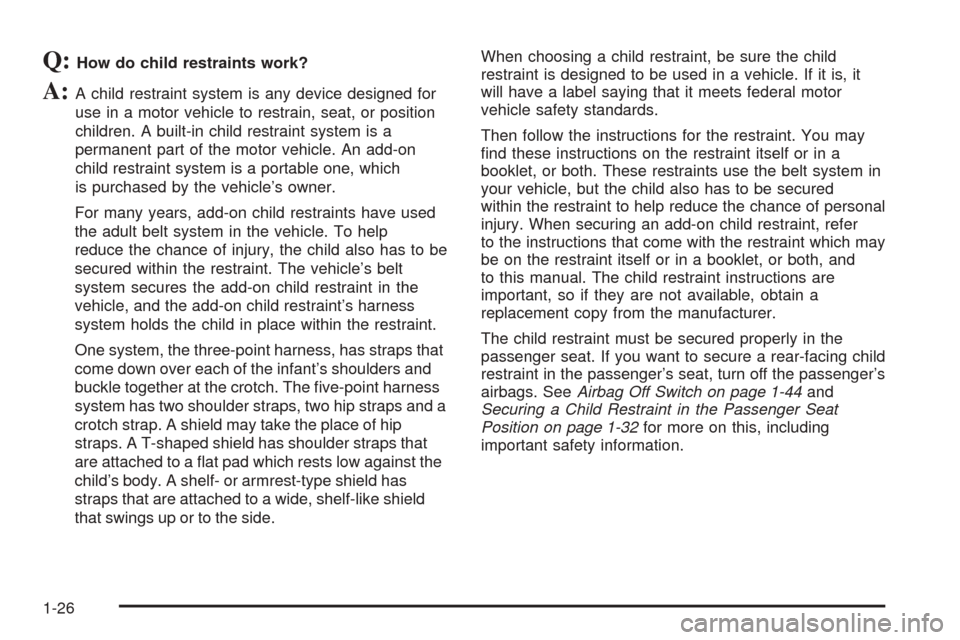
Q:How do child restraints work?
A:A child restraint system is any device designed for
use in a motor vehicle to restrain, seat, or position
children. A built-in child restraint system is a
permanent part of the motor vehicle. An add-on
child restraint system is a portable one, which
is purchased by the vehicle’s owner.
For many years, add-on child restraints have used
the adult belt system in the vehicle. To help
reduce the chance of injury, the child also has to be
secured within the restraint. The vehicle’s belt
system secures the add-on child restraint in the
vehicle, and the add-on child restraint’s harness
system holds the child in place within the restraint.
One system, the three-point harness, has straps that
come down over each of the infant’s shoulders and
buckle together at the crotch. The �ve-point harness
system has two shoulder straps, two hip straps and a
crotch strap. A shield may take the place of hip
straps. A T-shaped shield has shoulder straps that
are attached to a �at pad which rests low against the
child’s body. A shelf- or armrest-type shield has
straps that are attached to a wide, shelf-like shield
that swings up or to the side.When choosing a child restraint, be sure the child
restraint is designed to be used in a vehicle. If it is, it
will have a label saying that it meets federal motor
vehicle safety standards.
Then follow the instructions for the restraint. You may
�nd these instructions on the restraint itself or in a
booklet, or both. These restraints use the belt system in
your vehicle, but the child also has to be secured
within the restraint to help reduce the chance of personal
injury. When securing an add-on child restraint, refer
to the instructions that come with the restraint which may
be on the restraint itself or in a booklet, or both, and
to this manual. The child restraint instructions are
important, so if they are not available, obtain a
replacement copy from the manufacturer.
The child restraint must be secured properly in the
passenger seat. If you want to secure a rear-facing child
restraint in the passenger’s seat, turn off the passenger’s
airbags. SeeAirbag Off Switch on page 1-44and
Securing a Child Restraint in the Passenger Seat
Position on page 1-32for more on this, including
important safety information.
1-26
Page 33 of 438
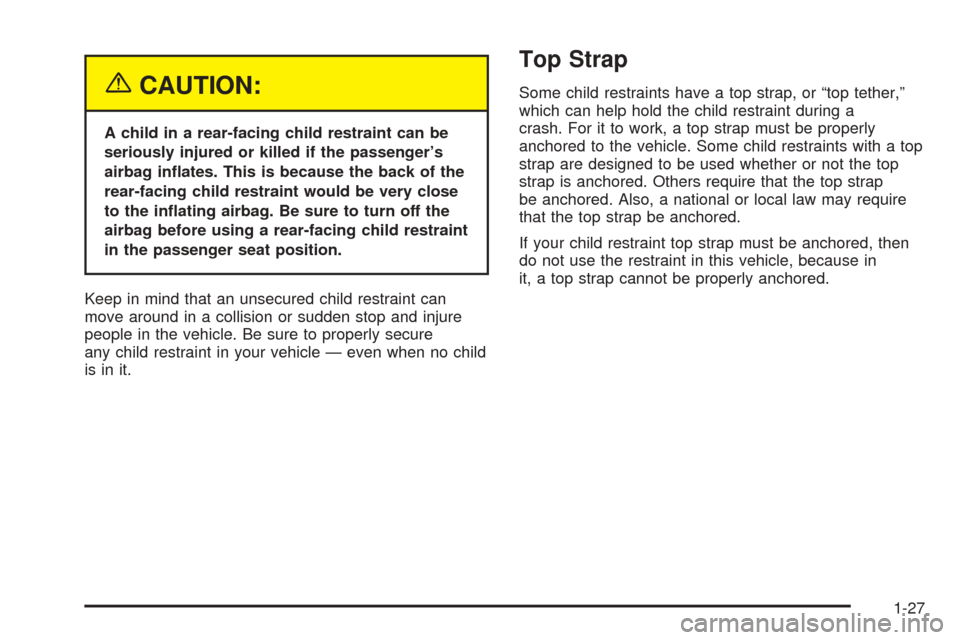
{CAUTION:
A child in a rear-facing child restraint can be
seriously injured or killed if the passenger’s
airbag in�ates. This is because the back of the
rear-facing child restraint would be very close
to the in�ating airbag. Be sure to turn off the
airbag before using a rear-facing child restraint
in the passenger seat position.
Keep in mind that an unsecured child restraint can
move around in a collision or sudden stop and injure
people in the vehicle. Be sure to properly secure
any child restraint in your vehicle — even when no child
is in it.
Top Strap
Some child restraints have a top strap, or “top tether,”
which can help hold the child restraint during a
crash. For it to work, a top strap must be properly
anchored to the vehicle. Some child restraints with a top
strap are designed to be used whether or not the top
strap is anchored. Others require that the top strap
be anchored. Also, a national or local law may require
that the top strap be anchored.
If your child restraint top strap must be anchored, then
do not use the restraint in this vehicle, because in
it, a top strap cannot be properly anchored.
1-27
Page 34 of 438
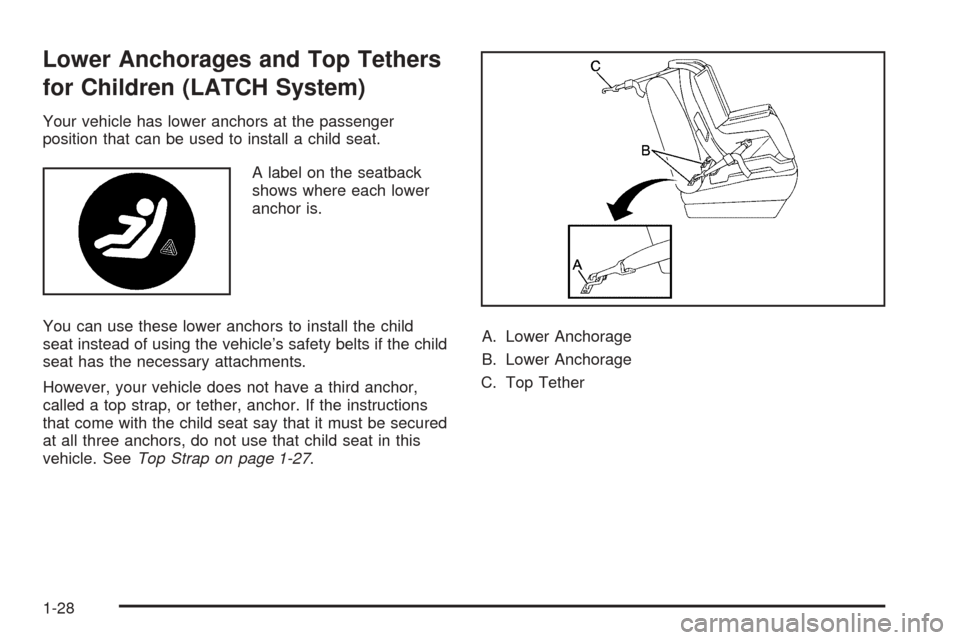
Lower Anchorages and Top Tethers
for Children (LATCH System)
Your vehicle has lower anchors at the passenger
position that can be used to install a child seat.
A label on the seatback
shows where each lower
anchor is.
You can use these lower anchors to install the child
seat instead of using the vehicle’s safety belts if the child
seat has the necessary attachments.
However, your vehicle does not have a third anchor,
called a top strap, or tether, anchor. If the instructions
that come with the child seat say that it must be secured
at all three anchors, do not use that child seat in this
vehicle. SeeTop Strap on page 1-27.A. Lower Anchorage
B. Lower Anchorage
C. Top Tether
1-28
Page 35 of 438
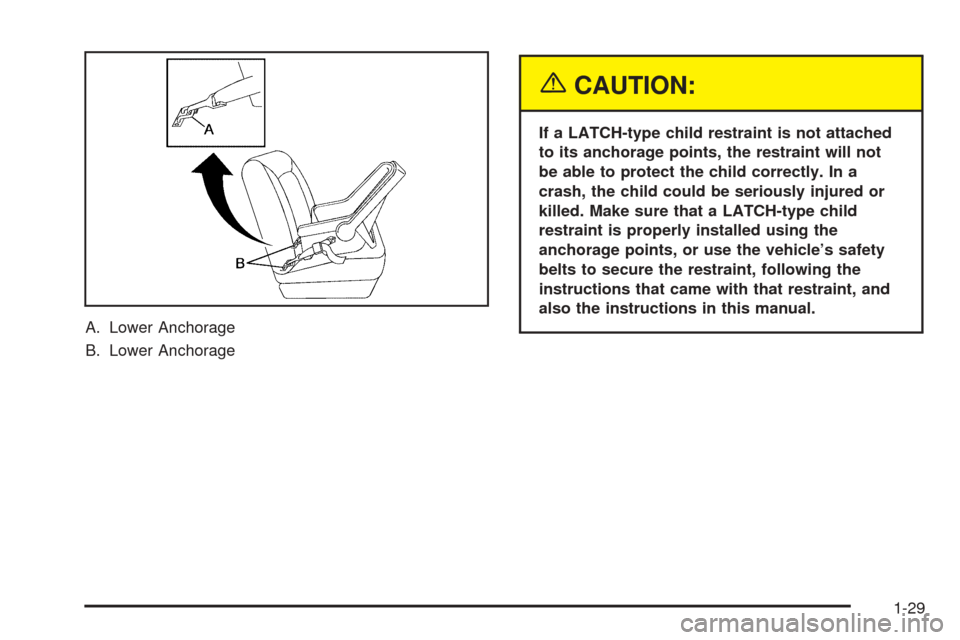
A. Lower Anchorage
B. Lower Anchorage
{CAUTION:
If a LATCH-type child restraint is not attached
to its anchorage points, the restraint will not
be able to protect the child correctly. In a
crash, the child could be seriously injured or
killed. Make sure that a LATCH-type child
restraint is properly installed using the
anchorage points, or use the vehicle’s safety
belts to secure the restraint, following the
instructions that came with that restraint, and
also the instructions in this manual.
1-29
Page 36 of 438
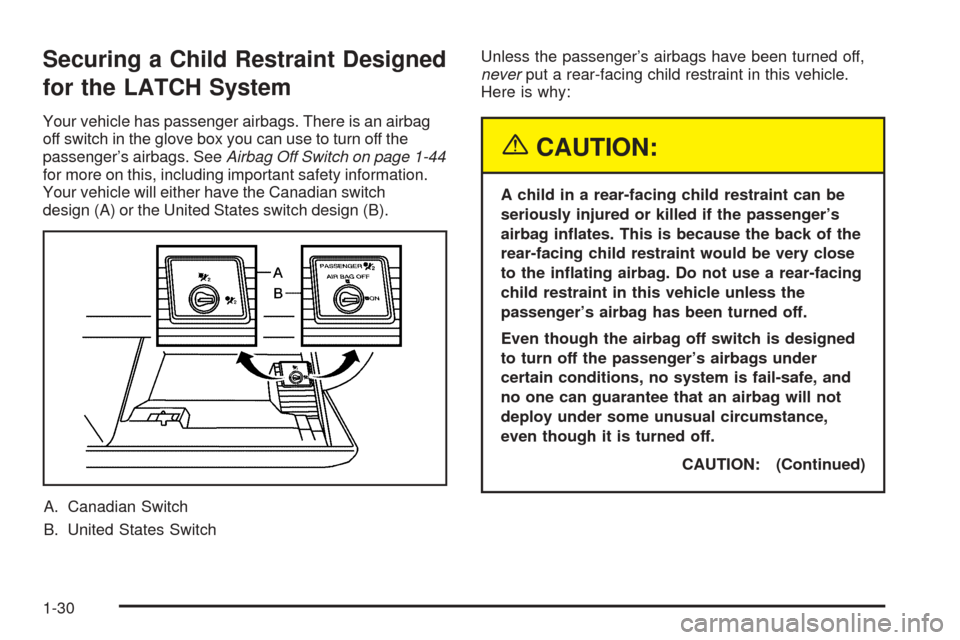
Securing a Child Restraint Designed
for the LATCH System
Your vehicle has passenger airbags. There is an airbag
off switch in the glove box you can use to turn off the
passenger’s airbags. SeeAirbag Off Switch on page 1-44
for more on this, including important safety information.
Your vehicle will either have the Canadian switch
design (A) or the United States switch design (B).
A. Canadian Switch
B. United States SwitchUnless the passenger’s airbags have been turned off,
neverput a rear-facing child restraint in this vehicle.
Here is why:
{CAUTION:
A child in a rear-facing child restraint can be
seriously injured or killed if the passenger’s
airbag in�ates. This is because the back of the
rear-facing child restraint would be very close
to the in�ating airbag. Do not use a rear-facing
child restraint in this vehicle unless the
passenger’s airbag has been turned off.
Even though the airbag off switch is designed
to turn off the passenger’s airbags under
certain conditions, no system is fail-safe, and
no one can guarantee that an airbag will not
deploy under some unusual circumstance,
even though it is turned off.
CAUTION: (Continued)
1-30